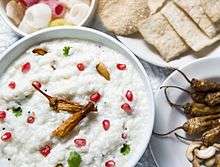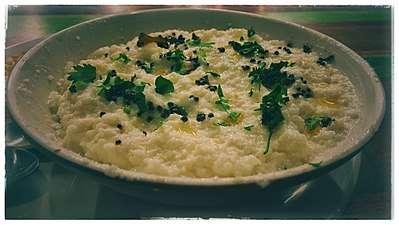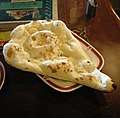Curd rice
Curd rice also called yogurt rice, is a dish originating from India. The word "curd" in Indian English refers to unsweetened probiotic yogurt. It is most popular in the Indian states of Tamil Nadu, Karnataka, Telangana and Andhra Pradesh.[1][2][3]
 | |
| Alternative names | Yogurt rice |
|---|---|
| Place of origin | India |
| Region or state | South Indian Cuisine |
| Main ingredients | Rice, yogurt, tempering |
In the state of Tamil Nadu it is called thayir saadam, and in Telangana and Andhra Pradesh it is called daddojanam. In Karnataka, it is called mosaranna. The dish is a staple of traditional cuisine, with the untempered version present at the end of almost every south indian meal. The tempered version is often served during formal occasions and also offered as prasadam (blessed food) to devotees in temples.
Preparation
While it is most easily prepared by simply mixing steamed white rice and yogurt, more elaborate methods can be used when needed. Rice is prepared either via steaming or pressure cooking to be soft as in the South Indian style[4]. It is then allowed to cool to room temperature, after which it is seasoned with finely chopped green chillies, ginger, and curry leaves, and sometimes along with the tadka of urad dal, mustard seeds, cumin seeds, and asafoetida. Finally, milk, yogurt, and salt are added.[1][2]
Alternatively, it can be prepared by mashing cooked plain rice (mostly leftovers) with some salt, yogurt and (a bit of milk to lessen the sour flavor of yogurt or to stop it from souring too much) garnishing it with fried urad dal, mustard seeds, green chilli and chopped cilantro. Also, adding a few chopped onions in bigger slices will help the curd rice from fermenting when required to be preserved.[1][2]
In some areas, curd rice is served in a unique style where steamed rice is mixed with mild curd, salted and then tempered with mustard seeds, curry leaves, dry chilies and urad dal. Garnishing varies with region, and range from grated carrots, pomegranate seeds, raisins, green and purple grapes, fried cashewnuts, grated raw mango and boondi. It can be served lukewarm or chilled. Additional options include a pinch of powdered and roasted asafoetida.[1][2]
Variations of the recipe are countless and are present in all states, reflecting the cuisine of each region. For example, in Karnataka, yoghurt chillies (sandige menasu) are commonly added as part of the tempering. Regardless of this, the base components of rice, yoghurt, tempered ingredients, and fresh ingredients are consistent, with the different ingredients included in each step varying.

Serving
Curd rice is often eaten accompanied by South Asian pickles. In South Indian cuisine, curd rice is traditionally eaten at the end of lunch and dinner, as this helps ease the effects of spicy food consumed prior.[1][2] It is also said to aid digestion, as well as to balance the effects of the warm climate.
See also
- Cuisine of India
- List of rice dishes
- Rice congee
- South Indian cuisine
- Udupi cuisine
References
- Chandra, Smita (1991). From Bengal to Punjab: The Cuisines of India. Crossing Press, p. 121.
- Plunkett, Richard, Teresa Cannon, Peter Davis, Paul Greenway, and Paul Harding (2001). Lonely Planet: South India, p. 127.
- Advantages of curd and curd rice:https://indianexpress.com/article/lifestyle/health/curd-rice-dahi-chawal-yoghurt-winter-6141196/
- Thayir Sadaam(Curd Rice):https://food.ndtv.com/recipe-thayir-saadam-curd-rice-218370


